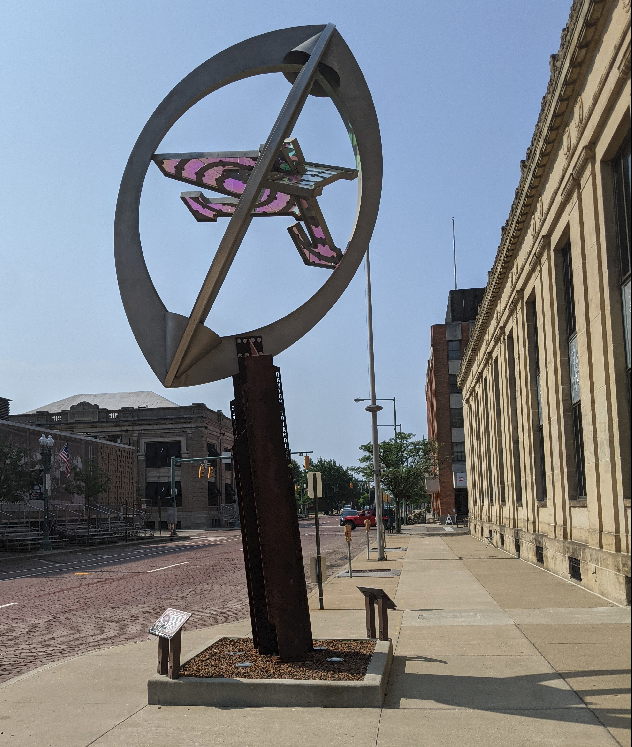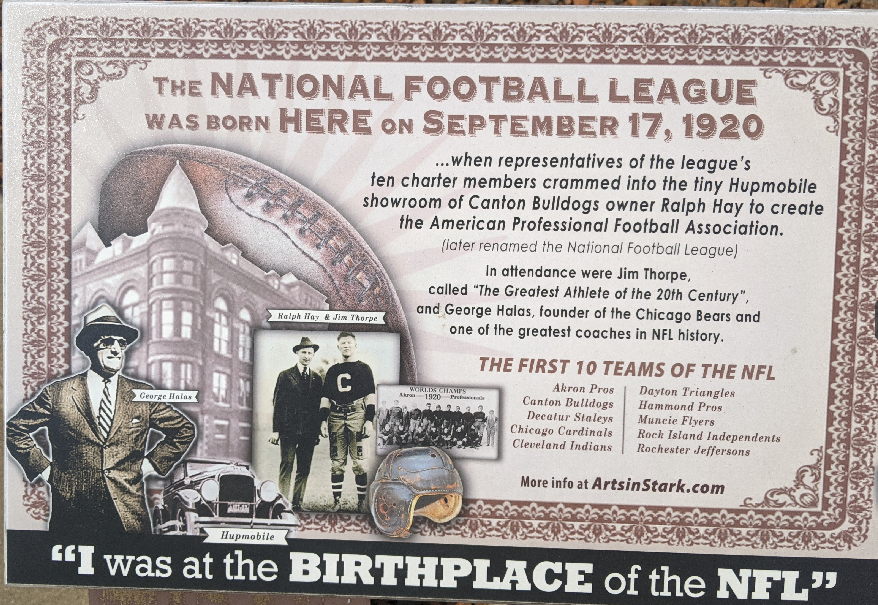Pro Football and in particular the NFL today is a Billion dollar business, but it was not always that way. Baseball and College football were much more popular than the pro version of the gridiron. This was so much the case that only a small percentage of the early pro teams survived beyond the Great Depression. Join us as we examine the climate of sports and the meeting that set the organized pro game in motion.
The Meeting that Started the NFL
The Popularity of Pro Football just after World War I
You have heard us through around the September 17, 1920 meeting in Canton, Ohio at Ralph Hay's Hupmobile Showroom quite a few times with guests and in posts and podcasts. What exactly was the significance of this famous meeting and who was in attendance? We take a deep dive into this pivotal gathering in this edition.

Location monument of Ralph Hay's Dealership in Canton, Ohio
First let's gt the lay of the land in football. College football was all the rave in 1920. Professional football was considered by many to be a bunch of college has beens trying to relive their past glory by some. Others like Walter Camp and Amos Alonzo Stagg pretty much despised players getting paid to play a game.
Julie Des Jardins, a professor of history at Baruch College, states in her biography of the gridiron founder, “Camp portrayed football, more than any other burgeoning sports, as providing the forced discipline, sense of danger, and physical hardening white college men needed to retain power in the modern age,” writes Des Jardins. The Father of modern football's basic philosophy was “Better make a boy an outdoor savage than an indoor weakling.” Camp even up to the time of his death was pleased with the spread of the college game that he helped to formulate. For God's Sake, the man died at the 1925 NCAA Football Rules convention but what did he think about the game spreading to pay players. It is hard to find evidence of his exact opinion of pro football but there are some bread crumb clues that we can piece together. Roger Tamte on his book on the man creditted with much of football's evolution from Rugby and Soccer, tells us that in one of his last interviews that Camp stated he was worried that football had gotten too big. He felt that at many universities it was overshadowing academics. What would he think of the pro game today with billions of dollars being made and some players only attending college to improve their draft status? I am not sure but I think he may frown on some of the by products that have occurred by his brilliant idea.
Amos Alonzo Stagg well we know exactly how he felt about players getting paid. He did not like it one bit. On more than one occassion Stagg spoke out against paying players. In Craig A. Coenen's book From the Sandlots to the Superbowl 1920-1967, the author states that Stagg threatened to have the University of Chicago sever all ties with players of the Maroons who went on to get paid professionally to play football. Coenen also quotes University of Michigan's head coach of the era, Fielding Yost as saying,"Good pay and short hours are deceptive...At 30 the boy is likely to be without a job, without a business or a profession."
The Meeting that started it all
So this meeting of brave men, pioneers in professional football were bucking the system of football in that era. College football was king and the crowds and publicity they drew proved it. But these men had a vision, one where great collegiate players could go on to play on the gridiron after graduation and play the game they loved, and maybe even possibly make a living at doing so.

Canton, Ohio painting on the side of a local business celebrating Hay and Thorpe.
Earlier attempts to form a pro league were thwarted by World War and the Spanish Flu Pandemic, but in 1920 the timing seemed right. Author Chris Willis in his great book The Man Who Built the National Football League: Joe F. Carr, says that only four of these franchises met in Hay's offices at the Hupmobile Showroom on August 20, 1920. Besides Hay and his Bulldogs players Jim Thorpe, Frank Neid and partner Art Ranney of the Akron Pros, Cleveland Indians manager Jimmy O'Donnell with PR dirctor Stanley Cofall and Carl Storck manager of the Triangles
Eleven franchise delegations met and each chipped in $100.00 to start the American Professional Football Association (which would change its name to the NFL in a couple years). There were not enough seats for everyone to have one so some of the guys sat on the floorboards of the cars in the showroom. Hay served prohibition draft beer in buckets for the men to drink while they talked. The teams represented were the Chicago Cardinals, Decatur Staleys, Canton Bulldogs, Muncie Flyers, Rock Island Independents, Hammond Pros, Rochester Jeffersons, Massillon Tigers, Cleveland Indians, Akron Pros and the Dayton Triangles.
The very first order of business was the withdrawal of the Massillon franchise from professional football in 1920. The league would pick up the Buffalo All-Americans, Columbus Panhandles, Detroit Heralds and the Chicago Tigers prior to the start of games being played. The first game featuring an AFPA team would be played on September 26, 1920.

Though teams changed names and locations, and most teams did not survive save the Cardinals and the Staleys who would later be rebranded as the Bears, the young League fought through some hard times, scandals, the Great Depression and even a second World War. However the dream that these earlier founders had would grow and I bet they would be proud to see what became of this unwanted professional football league in today's world.


